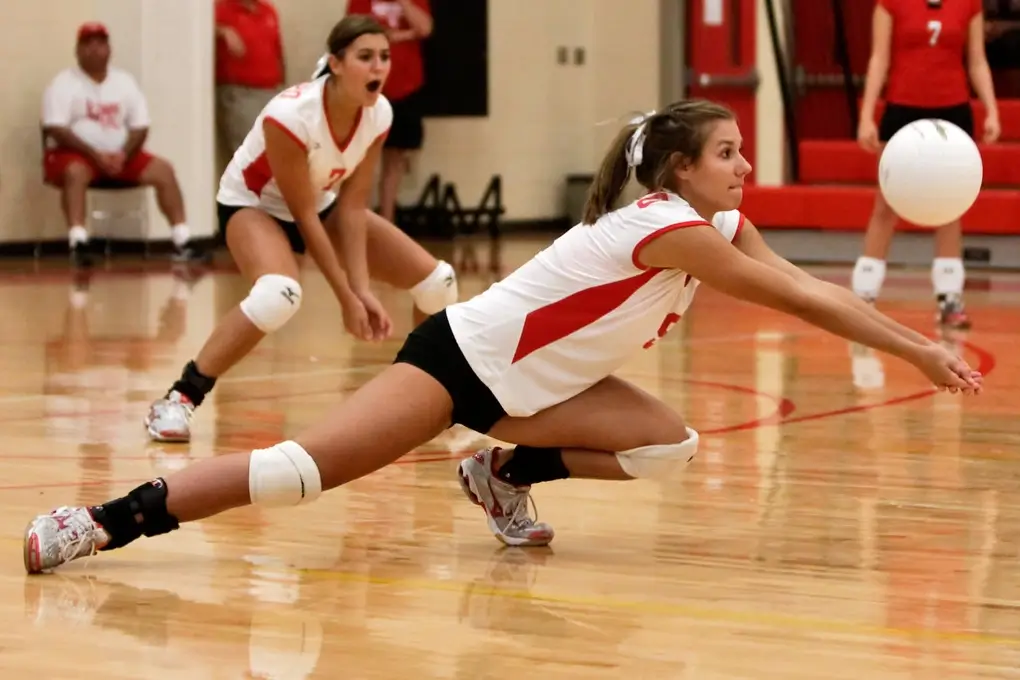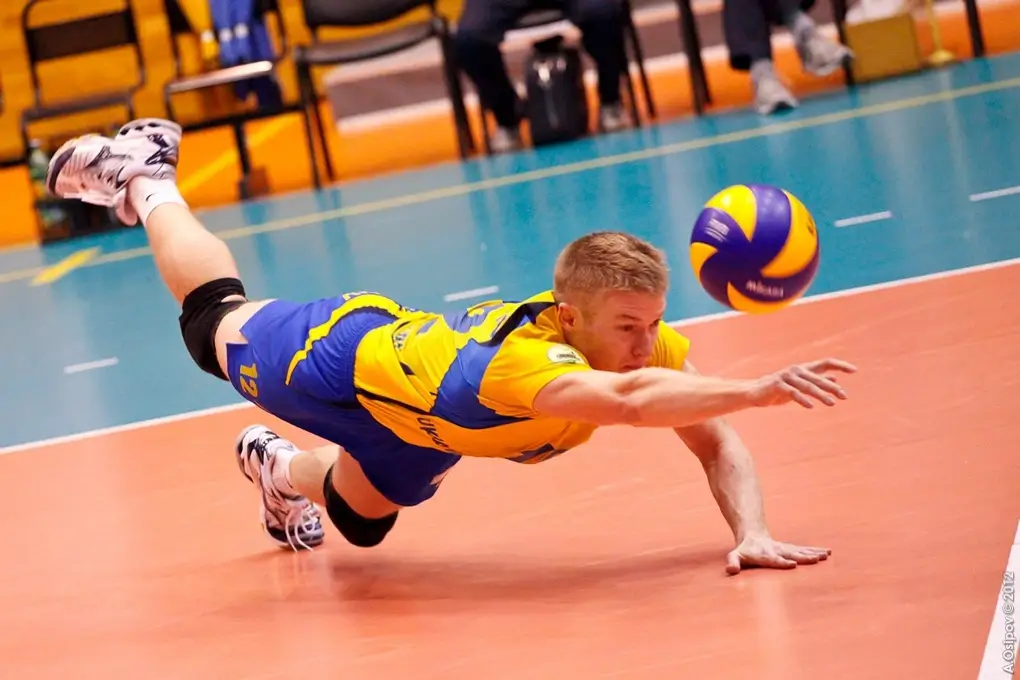Last Updated: February 9, 2024
Diving and digging are among the basic volleyball skills you should learn to be an expert defensive player. However, performing these skills can prove challenging in case of a brutal attack from your opponent. Proper body positioning, timely reaction, and enough preparation are key points for a successful dive or dig.
A strong attacker only has one intention: to spike the ball down hard and make it challenging for your team to defend.
No matter how hard the ball is coming, strive to prevent it from hitting the floor. But since it’s hard to predict each attack’s target area, every defense player should master both digging and diving skills for better team play.
What’s a Volleyball Dig?

A volleyball dig happens when you react to a hard spike from your opposing team. A dig may involve lunging, diving, or other movements to prevent the ball from touching the ground. A dig keeps the ball moving and gives your team a chance to attack back, which can change the outcome of the play.
Strategies for Perfecting Your Digging
1. Have a Defensive Mindset
Know about your fellow player’s whereabouts and your exact zone of coverage. Quickly gather information about your opponent. Is the opponent left-handed or right-handed? Are they on the front or back?
Also, observe their body language for tips on where the ball will go. This prepares you to defend appropriately, unlike when you are off-guard and make desperate moves, which cannot always result in a successful dig.
2. Be Ready
Always be in a ready stance for you to perform a successful dig. Position your hands, shoulders, hips, and feet so that you can quickly move to make a dig.
Additionally, have a proper vision of the court and the players. This way, you will know if you should take the dig or leave it to your fellow teammate.
3. Read Your Attacker
Get ready for the ball by analyzing your attacker’s intention. To determine their next action, look for pointers like the attacker’s body language, height, distance from the net, and arm movement.
Also, quickly interpret your attacker’s weaknesses to be better prepared when they next hold the ball. However, change your tactics constantly so your attackers don’t see your weak points.
4. Perform Drills to Perfect Your Digging
Digging is an art that’s learned through repetition. That’s why even players who become digging experts always keep training to iron their skillet.
Reacting Drill
Involves two players, the tosser who will stand behind the passer, and both should face a barrier or wall. The passer should take a defensive stand while the tosser throws the ball to the wall. The passer should view how the ball is coming and dig it up. A lower or harder toss leaves the defender with little time to react and, thus, difficult to pass. The difficulty level can be changed depending on how good the defender is.
Related: Common Digging Mistakes to Avoid
Repetition Drill
Although it’s good for the attacker to hit the ball harder to your defenders during practice, this can lead to horrible digs. Mark an area or box where the balls will be passed. The attacker hits the ball, and the defender should dig it into the drawn box. A defender will have difficulty digging a ball in a smaller box than in a larger one.
Reading Drill
A tosser holds a tennis ball in each hand while stretching arms out to their shoulder height. The passer should take a defensive stance and be ready to catch each tennis ball whenever it’s released. The further the players are, the harder it will be for the passer to react to the ball.
Here are some more digging drills.
5. Take Tips from Great Players
Find two or three mentors from the many great volleyball players you usually watch on TV. Watching your mentor’s body movement, reaction time, or real action and practicing them will elevate your digging skills.
What’s Diving in Volleyball?

Diving is a volleyball skill a player uses to prevent the ball from touching the ground or going out of bounds. While digs are the most commonly used technique to keep the ball off the ground, dives are used as the last effort or a desperation move. Though diving can be hard to master, it’s a very effective strategy for deflecting the ball from hitting the ground.
A successful dive prevents your opponents from scoring and keeps the ball going. Since you will deliberately contact some parts of your body with the ground, you should be extra careful to avoid injuries. It would be best to practice protecting your body when diving to land on the ground safely and recovering after hitting the ball.
Steps to Perfect Your Volleyball Dive
You might think it’s an easy maneuver or skill when you watch a player perform a dive. This is never the case, as diving is a technical skill requiring extra practice and professional coaching to master.
To be successful at diving, you should be able to coordinate your limbs, trunk, and upper body strength. Therefore, you should be careful not to hurt any parts of your body involved in making the dive.
1. Prepare Yourself
Be ready to defend as you watch the game develop on the other side, and have an exact vision of the direction the ball is going towards.
2. Execute
Do this by extending your arms before your body and falling outward but down. Your extension could be forward or sideways according to the direction the ball is coming.
3. Flight Phase
Keep your chin up as you slide and push the chest out to prevent injuries. Land with both hands, then quickly bend your support arm and extend your contact arm. Place the back of your contact hand where you project the ball to land.
4. Contact Phase
Still, keep your chin up as you watch the ball, let it make contact with the back of your hand, and bounce it off. In this state, your legs should be relaxed upwards, the stomach and chest slide forward, followed by the hips plus lower body.
Recommended read: How to Evaluate Your Team’s Digging and Diving Ability
5. Follow Through and Back to Base
Though you may be a good diver, you might find yourself often on the floor. Learn to recover from your current position and prepare for another play quickly. Try to minimize the time on the floor as you dive to improve your team’s chance to win the point.
After contacting the ball, roll to one side, then push the arms up to form a crawling posture. Next, put one hand on the floor, followed by the other and finally the knees. Quickly but carefully, stand up and return to your defensive stance.
6. Practise Drills to Perfect Your Diving
The Worm
This is where you put your chest down, legs up, and then down as you move forward, just like the worm. The worm drill is funny to play and helps to overcome mental blocks.
Moreover, moving like a worm allows you to conform your body to contact the ground safely when diving without injuries. The move also aids you to recover or roll off if need be.
Using a Mat
For beginners, you must start exercising with a mat to avoid injuries. This also helps to boost your confidence to pursue any given move. As you master the diving skill, slowly progress to practicing on the ground.
Partner Pass
This is a simple drill whereby you practice diving with your partner or coach. Let your partner toss the ball that’s hard for you to get; this leaves you with no option but to dive. For better practice, you can work in sets of three or five and switch positions.
Progressive Dive
Although this drill aims at building confidence, it can also enhance your diving skills. For this exercise, you begin with the previous and perform the next step repeatedly or try to change how you dive to make it less scary. For example, if you were diving from the knees, the progression would be from one leg to a crouching posture and finally to a standing or ready position.
Five-line Diving Drill
Coaches commonly call this a punishment or suicide drill. It’s rated among the fastest methods for improving your diving skills though. It requires about five players on the baseline, each running to the first line, touching it, and then sprinting back. So, after touching the line, get up quickly and run to the baseline.
Also read: Exploring Defensive Domination: How Digging and Diving Contribute to Winning
Scrimmage
Practice playing libero or defense even though you aren’t one. Defense players usually get many out-of-reach balls; thus, this exercise gives you more chances to counter those balls. Play this position regularly and record the number of balls you pick or touch successfully.
Diving Laps
This is a nice cool-down or warm-up exercise and can also serve as a punishment drill. It involves players moving around the court’s exterior boundaries in a lap with dives or diving footwork. Doing diving laps regularly helps improve your diving skills within a short period.
Conclusion
By now, you should be able to dig or dive a ball successfully to boost your team’s defense play. Although digging may seem more straightforward than diving, you can only perfect these skills through practice.
A defense player must learn both skills and know which to use in which scenario. Above all, have confidence that you will save all the balls aimed at you without minding how hard they are hit.
